Adjuncts in Homebrewed Beer: Introduction for Beginners
Published: July 20, 2025 at 10:59:13 AM UTC
Venturing beyond the basic ingredients of water, malt, hops, and yeast opens up a world of creative possibilities in homebrewing. Adjuncts can transform an ordinary beer into something extraordinary, adding unique flavors, aromas, and characteristics that make your brew truly stand out. Whether you're looking to brew a light, crisp lager with rice, a rich stout with coffee, or a fruity wheat beer, understanding adjuncts is your gateway to brewing innovation. This comprehensive guide will walk you through everything you need to know about using adjuncts in your homebrewed beer.
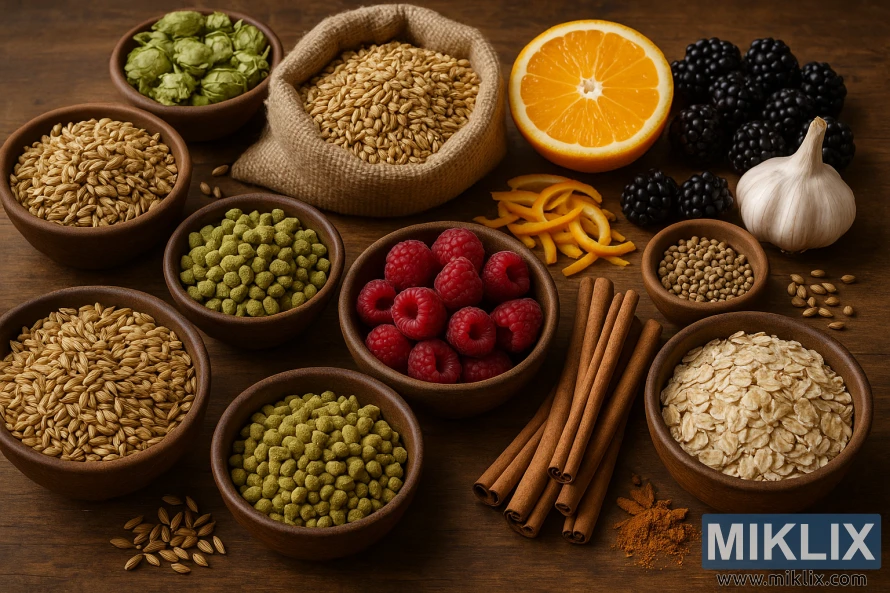
What Are Adjuncts and Why Use Them?
Common adjuncts used in homebrewing include grains, fruits, spices, and sugars
In brewing, adjuncts are any ingredients added to beer beyond the four traditional components: water, malted barley, hops, and yeast. They serve as supplementary sources of fermentable sugars and can significantly influence the character, flavor, and mouthfeel of your finished beer.
The Role of Adjuncts in Beer
Contrary to what some brewing purists might suggest, adjuncts aren't just cost-cutting measures. They play several important roles in brewing:
- Add unique flavors, aromas, and colors to your beer
- Lighten body and color in certain styles (like American lagers)
- Increase alcohol content without adding heaviness
- Improve head retention and stability
- Create distinctive regional beer styles
- Allow for creative experimentation in homebrewing
While the German Reinheitsgebot (beer purity law) of 1516 limited ingredients to water, malted barley, and hops (yeast wasn't yet understood), brewing traditions around the world have long embraced a wider variety of ingredients. Belgian brewers, for instance, have historically obtained fermentables from diverse sources, creating some of the world's most celebrated beer styles.
Types of Adjuncts for Homebrewing
Adjuncts can be broadly categorized into two main groups based on when they're added to the brewing process: mashable adjuncts and kettle adjuncts.
Mashable Adjuncts
Mashable adjuncts contain starch that needs to be converted to sugar before it can be used by brewer's yeast. These starchy adjuncts must be mashed, which means that enzymes degrade the starch to fermentable and unfermentable sugars and dextrins.
Rice
Contributes a light, dry character and produces a crisp, clean beer with less body. Used in many commercial American lagers.
Flavor contribution: Neutral, slightly dry
Common forms: Flaked rice, rice hulls, rice syrup
Corn (Maize)
Adds a subtle sweetness and smooth mouthfeel. Creates a lighter-colored beer with a distinctive character.
Flavor contribution: Slight sweetness, corn-like
Common forms: Flaked corn, corn grits, corn sugar
Oats
Creates a silky, creamy mouthfeel and adds body. Essential in oatmeal stouts and increasingly popular in New England IPAs.
Flavor contribution: Creamy, slightly nutty
Common forms: Flaked oats, oatmeal, malted oats
Wheat
Enhances head retention and creates a distinctive tangy flavor. Essential in wheat beers and adds protein haze.
Flavor contribution: Tangy, bready
Common forms: Flaked wheat, wheat malt, torrified wheat
Rye
Adds a spicy, distinctive character and dryness. Creates complexity in many beer styles.
Flavor contribution: Spicy, peppery, dry
Common forms: Flaked rye, rye malt
Unmalted Barley
Provides a grainy flavor and helps with head retention. Often used in Irish stouts.
Flavor contribution: Grainy, slightly harsh
Common forms: Flaked barley, torrefied barley
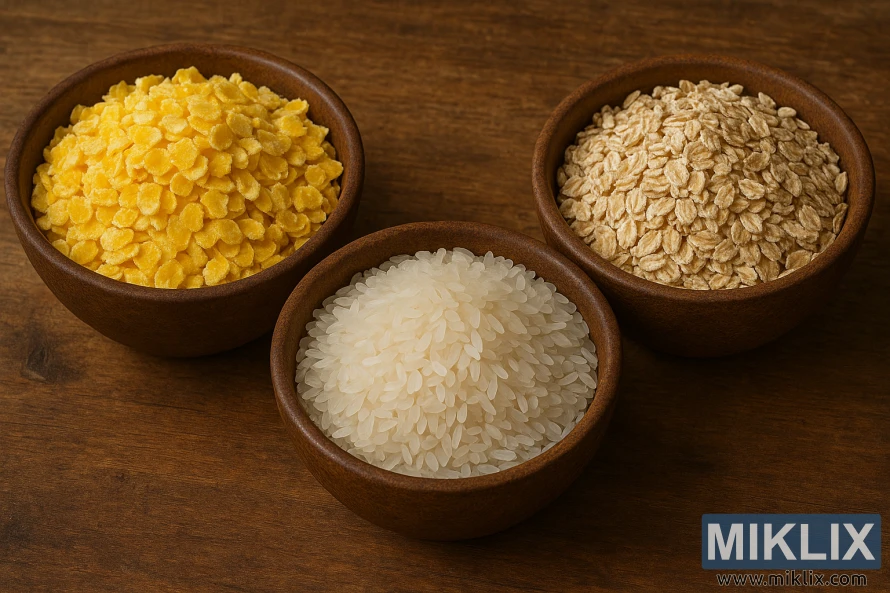
Kettle Adjuncts
Kettle adjuncts already contain soluble sugar and don't need to be mashed. These adjuncts are added to the wort during the boil and are called kettle adjuncts. This group includes a wide variety of sugars and syrups.
Honey
Adds fermentable sugars and subtle honey notes. Different varieties impart different flavors.
Flavor contribution: Varies by type, floral to earthy
Common use: 5-15% of fermentables
Maple Syrup
Contributes complex sugars and subtle maple character. Most flavor is lost in fermentation.
Flavor contribution: Subtle maple, caramel notes
Common use: 5-10% of fermentables
Belgian Candi Sugar
Adds fermentable sugars without body. Available in various colors for different flavor impacts.
Flavor contribution: Caramel, toffee, dark fruit
Common use: 5-20% of fermentables
Molasses
Provides dark color and rich, complex flavors. Use sparingly as it can dominate.
Flavor contribution: Rich, dark, slightly bitter
Common use: 2-5% of fermentables
Brown Sugar
Adds subtle caramel notes and fermentable sugars. Fully fermentable.
Flavor contribution: Mild caramel, molasses notes
Common use: 5-10% of fermentables
Fruit
Adds fruit character, fermentable sugars, and sometimes acidity. Can be added in boil or secondary.
Flavor contribution: Varies by fruit type
Common use: 0.5-2 lbs per gallon
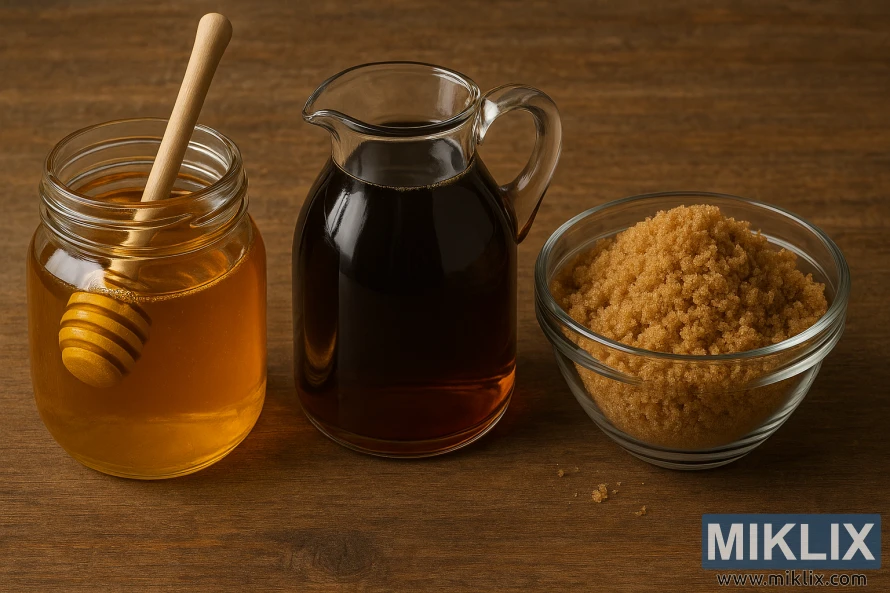
Flavor Adjuncts
Beyond providing fermentable sugars, many adjuncts are used primarily for their flavor contributions:
Coffee
Adds roasty, coffee flavors. Can be added as beans, grounds, or cold brew.
Pairs well with: Stouts, porters, brown ales
When to add: Secondary or at bottling
Spices
Adds complexity and distinctive character. Common spices include cinnamon, nutmeg, clove, and coriander.
Pairs well with: Winter ales, Belgian styles, wheat beers
When to add: Last 5-15 minutes of boil or secondary
Vanilla
Contributes smooth, sweet vanilla notes. Use beans, not extract for best results.
Pairs well with: Porters, stouts, brown ales
When to add: Secondary fermentation
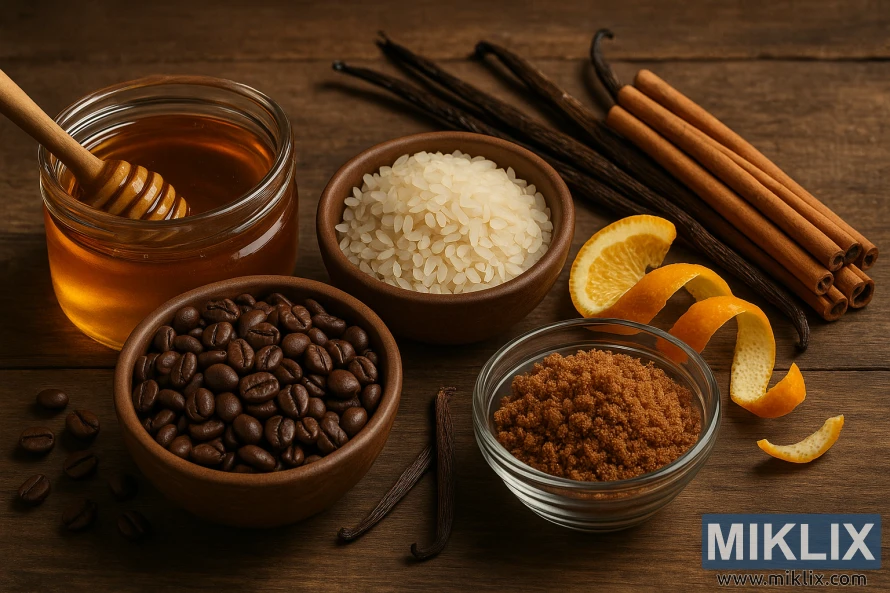
When to Add Adjuncts in the Brewing Process
The timing of adjunct addition is crucial to achieving the desired effect in your beer. Different adjuncts require different handling, and the point at which you add them can significantly impact the final result.
The timing of adjunct addition is crucial for extracting the desired flavors and characteristics
Adding Adjuncts During Mashing
Mashable adjuncts are added during the mashing stage, where they're mixed with malted barley. The enzymes from the barley convert the starches in both the barley and the adjuncts into fermentable sugars.
Gelatinization Considerations
Before the enzymes in the mash can break down the starch in cereal adjuncts, the starch must be gelatinized. Different adjuncts have different gelatinization temperatures:
| Adjunct | Gelatinization Temperature | Preparation Method |
| Wheat | 125.5° to 147° F | Can be added directly to mash |
| Barley (unmalted) | 140° to 143.5° F | Can be added directly to mash |
| Oats | 52.6° to 62° F | Can be added directly to mash |
| Rye | 50° to 62° F | Can be added directly to mash |
| Corn (maize) | 143.5° to 165° F | May require cereal mash or use flaked corn |
| Rice | 142° to 172° F | Requires cereal mash or use flaked rice |
Handling Different Mashable Adjuncts
- For adjuncts with low gelatinization temperatures (wheat, oats, rye), simply crush and add directly to your mash.
- For adjuncts with high gelatinization temperatures (corn, rice), either:
- Use pre-gelatinized forms like flaked or torrified versions
- Create a cereal mash by cooking the adjunct with a small amount of malted barley before adding to the main mash
- For extract brewers, perform a partial mash with your adjuncts and some base malt to convert the starches.
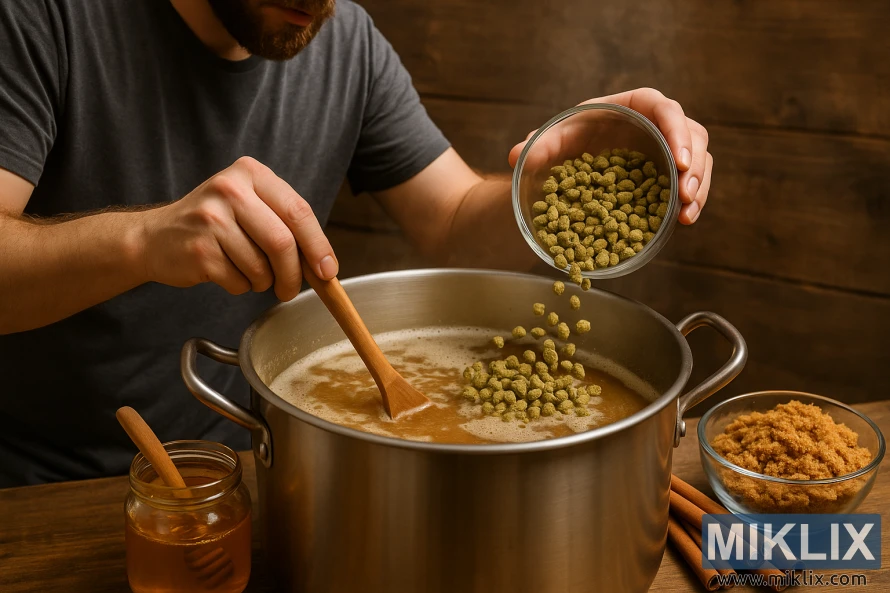
Adding Adjuncts During the Boil
Kettle adjuncts are added during the boil. Since they already contain fermentable sugars, they don't need enzymatic conversion.
Best Practices for Kettle Adjuncts
- Turn off the heat when adding sugary adjuncts to prevent scorching
- Stir thoroughly to ensure complete dissolution
- Add with at least 15 minutes left in the boil to ensure sanitization
- Consider adding later in the boil for better hop utilization
- For spices, add in the last 5-15 minutes to preserve volatile aromatics
Adding Adjuncts During or After Fermentation
Some adjuncts are best added during or after primary fermentation to preserve their delicate flavors and aromas.
Secondary Fermentation Adjuncts
- Fruit: Often added to secondary to preserve fresh fruit character
- Coffee: Can be added as cold brew at bottling or as beans/grounds in secondary
- Vanilla beans: Split and added to secondary for 1-2 weeks
- Oak chips or cubes: Added to secondary for woody, vanilla notes
- Dry spices: Can be added in a sanitized mesh bag for easy removal
Balancing Adjuncts with Base Ingredients
Using adjuncts successfully requires thoughtful consideration of how they'll interact with your base ingredients. The goal is to create a harmonious beer where adjuncts enhance rather than overwhelm.
Precise measurement of adjuncts is key to achieving balance in your beer
How Much Adjunct to Use
Finding the right amount of adjunct to use is crucial. Too little may go unnoticed, while too much can create an unbalanced beer.
| Adjunct Type | Recommended Usage Rate | Maximum Suggested | Effect on Beer |
| Rice/Corn | 10-20% of grain bill | 40% | Lightens body and flavor |
| Oats | 5-15% of grain bill | 30% | Increases body and silkiness |
| Wheat | 30-50% of grain bill | 70% | Adds tang and protein haze |
| Rye | 5-15% of grain bill | 20% | Adds spicy character |
| Honey | 5-15% of fermentables | 30% | Adds dryness and subtle honey notes |
| Fruit | 0.5-1 lb per gallon | 2 lbs per gallon | Adds fruit character and fermentables |
| Spices | 0.25-1 oz per 5 gallons | Varies by spice | Adds complexity and aroma |
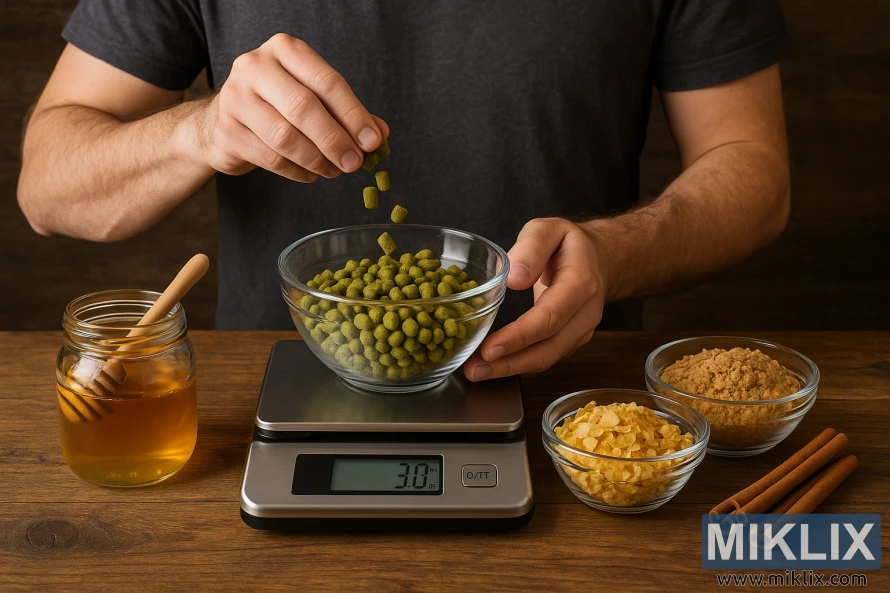
Pairing Adjuncts with Beer Styles
Different adjuncts complement different beer styles. Here are some classic pairings:
Light Lagers
Complementary adjuncts: Rice, corn, light honey
Why it works: These adjuncts lighten body and flavor, creating the crisp, clean character expected in light lagers.
Wheat Beers
Complementary adjuncts: Wheat (obviously), orange peel, coriander, fruit
Why it works: These adjuncts enhance the refreshing, zesty character of wheat beers.
Stouts & Porters
Complementary adjuncts: Oats, coffee, chocolate, vanilla, lactose
Why it works: These adjuncts complement and enhance the roasty, rich character of dark beers.
Tips for Balancing Adjunct Character
Do
- Start with less adjunct than you think you need – you can always add more in future batches
- Consider the beer style and how the adjunct will complement it
- Adjust other recipe elements to accommodate adjunct contributions
- Take detailed notes for future reference
- Use fresh, high-quality adjuncts for best results
Don't
- Add too many different adjuncts in one beer – complexity can become muddled
- Expect adjuncts to fix a flawed base beer
- Forget to account for adjunct contributions to fermentables
- Ignore the impact on mouthfeel and body
- Skip sanitization for adjuncts added post-boil
Simple Adjunct Beer Recipes for Beginners
Ready to try brewing with adjuncts? Here are three approachable recipes that showcase different types of adjuncts and how they can enhance your homebrewed beer.
From left to right: Honey Blonde Ale, Coffee Oatmeal Stout, and Citrus Wheat Beer
Recipe #1: Honey Blonde Ale
This approachable blonde ale uses honey as a kettle adjunct to add subtle sweetness and aroma while boosting alcohol content without adding body.
Ingredients (5 gallons/19 liters)
- 7 lbs (3.2 kg) Pale Malt Extract
- 1 lb (0.45 kg) Local Honey (added during last 15 minutes of boil)
- 0.5 lb (0.23 kg) Crystal 15L Malt (steeped)
- 1 oz (28 g) Cascade Hops (5.5% AA) - 60 minutes
- 0.5 oz (14 g) Cascade Hops (5.5% AA) - 15 minutes
- Safale US-05 American Ale Yeast
- Priming sugar for bottling
Brewing Instructions
- Steep crushed Crystal malt in 2.5 gallons (9.5 liters) of water at 150-160°F (65-71°C) for 30 minutes.
- Remove grains, bring to a boil, and turn off heat.
- Add malt extract, stirring to dissolve completely.
- Return to boil, add 60-minute hop addition.
- With 15 minutes remaining, add 15-minute hop addition and honey.
- Cool wort to 65-70°F (18-21°C), transfer to fermenter, and top up to 5 gallons (19 liters).
- Aerate thoroughly and pitch yeast.
- Ferment at 65-70°F (18-21°C) for 2 weeks.
- Bottle or keg with appropriate priming sugar.
Expected OG: 1.052 | Expected FG: 1.010 | ABV: ~5.5% | IBU: ~25
Adjunct Tip: Different honey varieties will contribute different flavors. Lighter honeys (clover, orange blossom) provide subtle character, while darker honeys (buckwheat, avocado) contribute more pronounced flavors.
Recipe #2: Coffee Oatmeal Stout
This rich stout uses two adjuncts: oats for a silky mouthfeel and coffee for a complementary roasty flavor.
Ingredients (5 gallons/19 liters)
- 6 lbs (2.7 kg) Dark Malt Extract
- 1 lb (0.45 kg) Flaked Oats (partial mash)
- 0.5 lb (0.23 kg) Chocolate Malt (partial mash)
- 0.5 lb (0.23 kg) Roasted Barley (partial mash)
- 0.5 lb (0.23 kg) Crystal 60L Malt (partial mash)
- 1.5 oz (42 g) East Kent Goldings Hops (5% AA) - 60 minutes
- 4 oz (113 g) coarsely ground coffee beans (added to secondary)
- Wyeast 1084 Irish Ale Yeast or White Labs WLP004
- Priming sugar for bottling
Brewing Instructions
- Conduct a partial mash with flaked oats and specialty grains in 1.5 gallons (5.7 liters) of water at 150-155°F (65-68°C) for 45 minutes.
- Strain liquid into brew kettle, rinse grains with 1 gallon (3.8 liters) of hot water.
- Top up to 3 gallons (11.4 liters), bring to a boil, and turn off heat.
- Add malt extract, stirring to dissolve completely.
- Return to boil, add hops, and boil for 60 minutes.
- Cool wort to 65-68°F (18-20°C), transfer to fermenter, and top up to 5 gallons (19 liters).
- Aerate thoroughly and pitch yeast.
- Ferment at 65-68°F (18-20°C) for 1-2 weeks.
- Transfer to secondary fermenter and add coffee beans (in a sanitized mesh bag) for 24-48 hours.
- Bottle or keg with appropriate priming sugar.
Expected OG: 1.058 | Expected FG: 1.016 | ABV: ~5.5% | IBU: ~35
Adjunct Tip: The coffee character will develop over time. For a more subtle coffee note, use 2-3 oz for 24 hours. For stronger coffee presence, use 4-6 oz for 48 hours.
Recipe #3: Citrus Wheat Beer
This refreshing wheat beer uses wheat as a mashable adjunct and orange peel and coriander as flavor adjuncts.
Ingredients (5 gallons/19 liters)
- 4 lbs (1.8 kg) Wheat Malt Extract
- 2 lbs (0.9 kg) Light Malt Extract
- 1 oz (28 g) Hallertau Hops (4.5% AA) - 60 minutes
- 0.5 oz (14 g) Hallertau Hops (4.5% AA) - 15 minutes
- 1 oz (28 g) Sweet Orange Peel - 5 minutes
- 0.5 oz (14 g) Coriander Seed (crushed) - 5 minutes
- Wyeast 3944 Belgian Witbier Yeast or White Labs WLP400
- Priming sugar for bottling
Brewing Instructions
- Bring 3 gallons (11.4 liters) of water to a boil, then turn off heat.
- Add malt extracts, stirring to dissolve completely.
- Return to boil, add 60-minute hop addition.
- With 15 minutes remaining, add 15-minute hop addition.
- With 5 minutes remaining, add orange peel and crushed coriander.
- Cool wort to 65-70°F (18-21°C), transfer to fermenter, and top up to 5 gallons (19 liters).
- Aerate thoroughly and pitch yeast.
- Ferment at 65-72°F (18-22°C) for 2 weeks.
- Bottle or keg with appropriate priming sugar.
Expected OG: 1.048 | Expected FG: 1.012 | ABV: ~4.7% | IBU: ~18
Adjunct Tip: Use sweet orange peel, not bitter orange peel, for a more pleasant citrus character. Fresh-grated zest can also be used but add it in the last minute of the boil to preserve the aromatic oils.
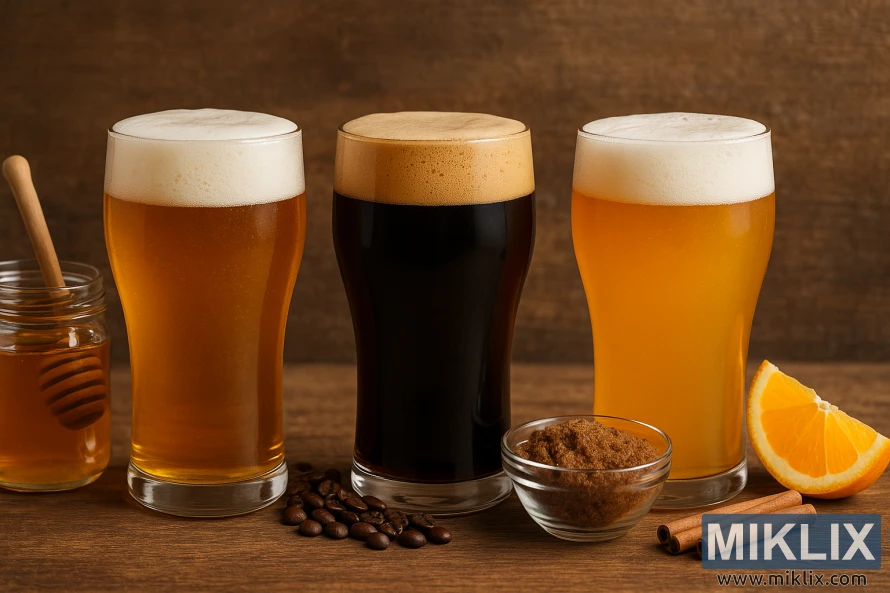
Common Mistakes and Troubleshooting
Even experienced brewers can run into challenges when working with adjuncts. Here are some common issues and how to address them.
Identifying and solving problems is part of the learning process when brewing with adjuncts
Mistake #1: Using Too Much Adjunct
The Problem
Excessive use of adjuncts can lead to fermentation problems, overwhelming flavors, or beer that doesn't taste like beer anymore.
Signs You've Used Too Much
- Stuck fermentation or incomplete attenuation
- Overpowering adjunct flavor that masks other beer characteristics
- Excessive sweetness or dryness
- Poor head retention or unusual mouthfeel
How to Fix It
For an already brewed batch:
- Blend with a non-adjunct beer of similar style
- Add additional hops to balance sweetness if appropriate
- For stuck fermentation, add yeast nutrients and rouse or repitch yeast
- Give it time—some adjunct flavors will mellow with age
Prevention
Start with smaller amounts of adjuncts than recipes suggest, especially for strong-flavored ingredients. You can always add more in your next batch.
Mistake #2: Poor Adjunct Preparation
The Problem
Improper preparation of starchy adjuncts can lead to poor extraction, hazy beer, or stuck mashes.
Signs of Poor Preparation
- Slow or stuck runoff during lautering
- Lower than expected original gravity
- Starch haze in the finished beer
- Grainy, raw flavors in the finished beer
How to Fix It
For an already brewed batch:
- Extended conditioning may help with some flavor issues
- For starch haze, try using a product with amylase enzymes
- Fining agents may help with clarity issues
Prevention
- Ensure proper gelatinization of starchy adjuncts
- Use rice hulls when brewing with high percentages of huskless grains
- Consider using flaked or pre-gelatinized forms of high-gelatinization adjuncts
- Conduct an iodine test to confirm complete starch conversion
Mistake #3: Contamination from Adjuncts
The Problem
Adjuncts added after the boil can introduce wild yeast or bacteria if not properly sanitized.
Signs of Contamination
- Off-flavors: sour, medicinal, or funky notes not appropriate to style
- Continued fermentation in bottles leading to overcarbonation or "gushers"
- Pellicle formation or unusual growth in fermenter
- Unexpected turbidity or rope-like strands in beer
How to Fix It
For an already contaminated batch:
- If caught early, pasteurization might salvage the batch
- In some cases, aging can transform it into an interesting "wild" beer
- Often, the best solution is to learn from the experience and start fresh
Prevention
- Sanitize all adjuncts added after the boil
- For items that can't be chemically sanitized, consider:
- Soaking in high-proof, neutral spirits
- Brief pasteurization in oven (for spices, etc.)
- Adding during the last 5 minutes of the boil
- Use mesh bags for easy removal of solid adjuncts
Mistake #4: Ignoring Adjunct Impact on Recipe Balance
The Problem
Failing to adjust other recipe elements to accommodate adjunct contributions can lead to unbalanced beer.
Signs of Recipe Imbalance
- Higher or lower alcohol content than expected
- Inappropriate body for the style (too thin or too heavy)
- Unbalanced sweetness or bitterness
- Clashing flavors between adjuncts and other ingredients
How to Fix It
For an already brewed batch:
- Blending with another beer can help balance flavors
- Extended aging may help flavors meld
- Adjust serving temperature to emphasize or de-emphasize certain characteristics
Prevention
- Account for fermentable contributions from adjuncts in your recipe calculations
- Adjust base malt quantities when using large amounts of fermentable adjuncts
- Consider how adjuncts will affect final gravity and mouthfeel
- Adjust hop additions to balance sweetness from certain adjuncts

Frequently Asked Questions About Brewing with Adjuncts
Understanding adjuncts helps you make informed decisions for your homebrewing recipes
Can adjuncts completely replace base malts?
No, adjuncts should generally not completely replace base malts. Most adjuncts lack the enzymes needed to convert their own starches into fermentable sugars. Barley malt provides these essential enzymes, as well as proteins, vitamins, and minerals that yeast need for healthy fermentation.
While some beers can be brewed with very high adjunct percentages (up to 40-50% for some styles), you'll almost always need some base malt. The exception would be if you're using only fermentable sugar adjuncts (like honey or cane sugar) and malt extract, which has already had its starches converted to sugars.
How much adjunct is too much?
The "right" amount of adjunct varies by type and beer style, but there are some general guidelines:
- Starchy adjuncts (rice, corn, wheat): Generally keep below 40% of the grain bill. Beyond this, you may encounter conversion or lautering issues.
- Sugar adjuncts (honey, maple syrup): Keep below 20% of fermentables to avoid stressing yeast or creating a cidery character.
- Flavor adjuncts (spices, coffee): Start with much less than you think you need—you can always add more, but you can't take it out.
The best approach is to start conservative and increase in subsequent batches if desired. Remember that adjuncts should enhance your beer, not dominate it.
Do I need special equipment to brew with adjuncts?
For most homebrewing with adjuncts, no special equipment is needed beyond your standard brewing setup. However, a few items can be helpful:
- Mesh bags: Useful for containing solid adjuncts during boil or fermentation
- Rice hulls: Not equipment, but essential when using high percentages of huskless grains to prevent stuck mashes
- Secondary fermenter: Helpful when adding adjuncts after primary fermentation
- Cereal cooker: For advanced brewers using raw grains with high gelatinization temperatures
Extract brewers can easily use most adjuncts without any additional equipment, making them a great way to experiment with different flavors.
Will adjuncts affect the shelf life of my beer?
Adjuncts can impact shelf life in several ways:
- Fruit adjuncts: May reduce shelf stability due to additional compounds that can oxidize
- Spices: Some spice compounds can fade relatively quickly
- Sugar adjuncts: Generally improve shelf stability by reducing protein content
- Grain adjuncts: Can either improve or reduce stability depending on type
To maximize shelf life when using adjuncts:
- Ensure complete fermentation before packaging
- Be extra careful about sanitation with post-boil adjunct additions
- Store beer cool and dark to preserve adjunct flavors
- Consider the style—some adjunct beers are meant to be consumed fresh
Can I use adjuncts in extract brewing?
Absolutely! Extract brewing is actually an excellent way to experiment with adjuncts. Here's how to approach different types:
- Kettle adjuncts (sugars, syrups): Simply add during the boil
- Flavor adjuncts (spices, fruit): Add during boil, at flameout, or in secondary as appropriate
- Starchy adjuncts (grains): Conduct a partial mash with some base malt to convert starches
For extract brewers, adjuncts provide an easy way to create unique beers without the complexity of all-grain brewing. Many of the recipes in this guide can be adapted for extract brewing with minimal changes.
How do adjuncts affect the nutritional profile of beer?
Different adjuncts can significantly alter the nutritional profile of beer:
- Calorie content: Sugar adjuncts may increase alcohol without adding body, potentially increasing calories
- Gluten content: Rice, corn, and sorghum can reduce gluten levels compared to all-barley beers
- Antioxidants: Fruit adjuncts and certain grains like buckwheat can increase polyphenol content
- Vitamins and minerals: Adjuncts like oats can add nutritional elements not present in barley
While beer should never be considered primarily as a health food, certain adjuncts can contribute positive nutritional elements. For those with dietary restrictions, adjuncts can make beer more accessible (e.g., gluten-reduced beers using rice or sorghum).
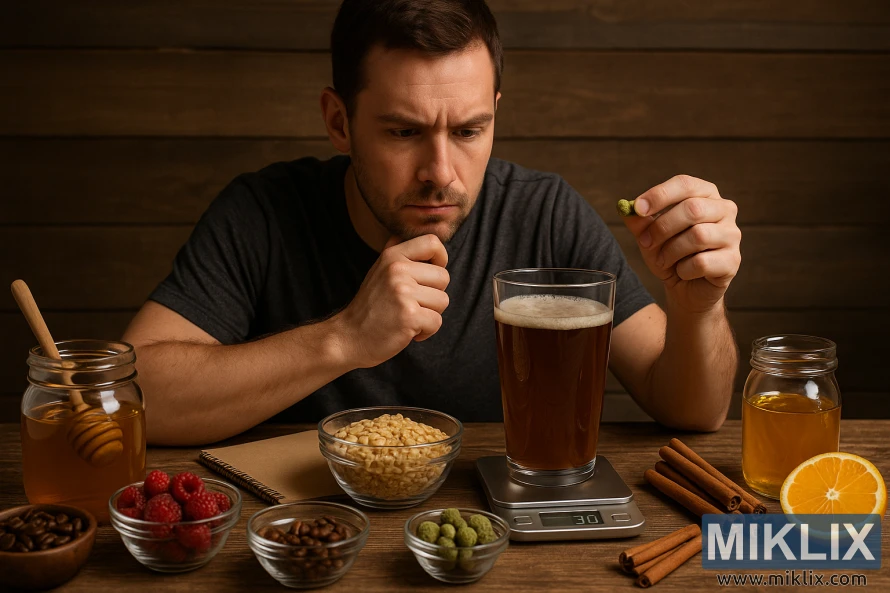
Conclusion
Brewing with adjuncts opens up a world of creative possibilities for homebrewers. From lightening the body of a summer lager with rice to creating a complex, coffee-infused stout, adjuncts allow you to craft beers that express your unique brewing vision.
Remember that successful brewing with adjuncts requires understanding their properties, proper preparation, and thoughtful integration into your recipes. Start with modest amounts, take detailed notes, and don't be afraid to experiment. Some of the world's most beloved beer styles rely heavily on adjuncts—from Belgian witbiers with their orange peel and coriander to rich oatmeal stouts.
As you gain experience, you'll develop an intuitive sense of how different adjuncts interact with other ingredients and how they can be used to achieve specific flavor profiles. The recipes and guidelines in this article provide a starting point, but the true joy of homebrewing lies in making each batch your own.
So gather your ingredients, heat up your brew kettle, and start exploring the fascinating world of brewing with adjuncts. Your next favorite homebrew is waiting to be created!
The satisfaction of enjoying a unique beer crafted with your own choice of adjuncts is unmatched
Further Reading
If you enjoyed this post, you may also like these suggestions:
- Using Oats as an Adjunct in Beer Brewing
- Using Honey as an Adjunct in Beer Brewing
- Using Rice as an Adjunct in Beer Brewing
